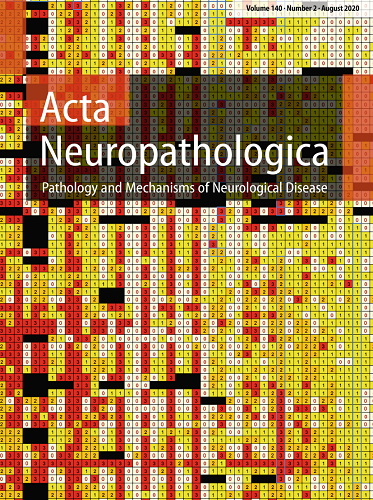LRRK2 kinase-mediated accumulation of lysosome-associated phospho-Rabs in tauopathies and synucleinopathies.
IF 9.3
1区 医学
Q1 CLINICAL NEUROLOGY
引用次数: 0
Abstract
Parkinson's disease (PD) pathogenic mutations in leucine-rich repeat kinase 2 (LRRK2) are associated with endolysosomal dysfunction across cell types, and carriers of LRRK2 mutations variably present with phosphorylated tau and α-synuclein deposits in post-mortem analysis. LRRK2 mutations increase the phosphorylation of Rab substrates including Rab12 and Rab10. Rab12 and Rab10 are expressed in neuronal and non-neuronal cells with localization to membranes in the endolysosomal compartment, and lysosomal stress activates LRRK2 phosphorylation of Rabs. In this study, using antibodies directed to the LRRK2-mediated phosphorylation sites on Rab12 at amino acid Ser106 (pS106-Rab12) and Rab10 at amino acid Thr73 (pT73-Rab10), we test whether aberrant LRRK2 phosphorylation is associated with tau and/or α-synuclein pathology across clinically distinct neurodegenerative diseases. Analysis of brain tissue lysates and immunohistochemistry of pathology-susceptible brain regions demonstrate that pS106-Rab12 levels are increased in Alzheimer's disease (AD) and Lewy body disease (LBD), including PD with and without G2019S LRRK2 mutation. At early pathological stages, phosphorylated Rab12 localizes to granulovacuolar degeneration bodies (GVBs), which are thought to be active lysosomal-like structures, in neurons. pS106-Rab12-positive GVBs accumulate with pathological tau across brain tissues in AD and LBD, and in G2019S LRRK2 mutation carriers. In a mouse model of tauopathy, pS106-Rab12 localizes to GVBs during early tau deposition in an age-dependent manner. While GVBs are largely absent in neurons with mature protein pathology, subsets of both tau and α-synuclein inclusions appear to incorporate pS106-Rab12 at later pathological stages. Further, pS106-Rab12 labels GVBs in neurons and shows co-pathology with tau inclusions in primary tauopathies including Pick's disease, progressive supranuclear palsy, and corticobasal degeneration. Finally, pT73-Rab10 is elevated and localizes to GVBs, but not tau and α-synuclein inclusions, in AD and LBD, including G2019S LRRK2 mutation carriers. These results implicate LRRK2 kinase activity and Rab phosphorylation in endolysosomal dysfunction in tau- and α-synuclein-associated neurodegenerative diseases.在tau病和突触核蛋白病中,LRRK2激酶介导的溶酶体相关磷酸化rabs的积累。
富亮氨酸重复激酶2 (LRRK2)致病性突变与各种细胞类型的内溶酶体功能障碍相关,LRRK2突变携带者在死后分析中以磷酸化的tau和α-突触核蛋白沉积的形式不同地存在。LRRK2突变增加了Rab12和Rab10等rabb底物的磷酸化。Rab12和Rab10在神经元和非神经元细胞中表达,定位于内溶酶体腔室的膜上,溶酶体应激激活Rabs的LRRK2磷酸化。在本研究中,我们利用抗体靶向LRRK2介导的Rab12氨基酸Ser106位点(pS106-Rab12)和Rab10氨基酸Thr73位点(pT73-Rab10),检测LRRK2异常磷酸化是否与临床不同神经退行性疾病的tau和/或α-突触核蛋白病理相关。脑组织裂解物和病理易感脑区免疫组化分析表明,pS106-Rab12水平在阿尔茨海默病(AD)和路易体病(LBD)中升高,包括PD伴和不伴G2019S LRRK2突变。在早期病理阶段,磷酸化的Rab12定位于颗粒空泡变性体(GVBs),这被认为是神经元中活性溶酶体样结构。在AD和LBD以及G2019S LRRK2突变携带者中,ps106 - rab12阳性GVBs与病理性tau一起在脑组织中积累。在小鼠tau病模型中,pS106-Rab12在早期tau沉积过程中以年龄依赖的方式定位于GVBs。虽然GVBs在成熟蛋白病理的神经元中大量缺失,但在病理后期,tau和α-突触核蛋白内含物的亚群似乎与pS106-Rab12结合。此外,pS106-Rab12标记神经元中的GVBs,并在原发性tau病(包括皮克病、进行性核上性麻痹和皮质基底变性)中显示与tau内含物的共同病理。最后,在AD和LBD(包括G2019S LRRK2突变携带者)中,pT73-Rab10升高并定位于GVBs,但不定位于tau和α-突触核蛋白内含体。这些结果暗示LRRK2激酶活性和Rab磷酸化与tau-和α-突触核蛋白相关的神经退行性疾病的内溶酶体功能障碍有关。
本文章由计算机程序翻译,如有差异,请以英文原文为准。
求助全文
约1分钟内获得全文
求助全文
来源期刊

Acta Neuropathologica
医学-病理学
CiteScore
23.70
自引率
3.90%
发文量
118
审稿时长
4-8 weeks
期刊介绍:
Acta Neuropathologica publishes top-quality papers on the pathology of neurological diseases and experimental studies on molecular and cellular mechanisms using in vitro and in vivo models, ideally validated by analysis of human tissues. The journal accepts Original Papers, Review Articles, Case Reports, and Scientific Correspondence (Letters). Manuscripts must adhere to ethical standards, including review by appropriate ethics committees for human studies and compliance with principles of laboratory animal care for animal experiments. Failure to comply may result in rejection of the manuscript, and authors are responsible for ensuring accuracy and adherence to these requirements.
 求助内容:
求助内容: 应助结果提醒方式:
应助结果提醒方式:


